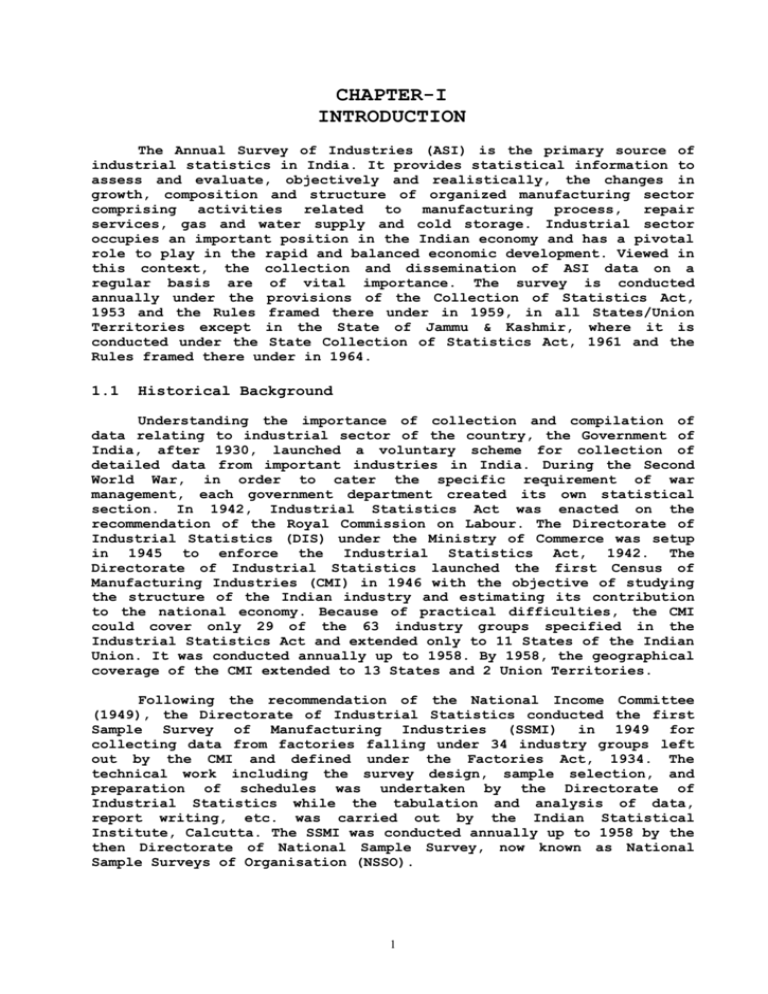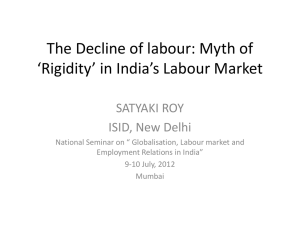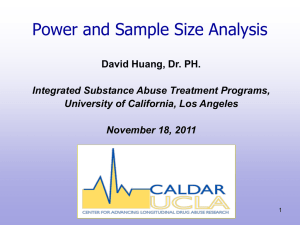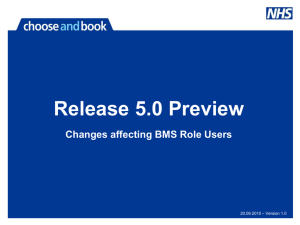Chapter-I - Labour Bureau
advertisement

CHAPTER-I INTRODUCTION The Annual Survey of Industries (ASI) is the primary source of industrial statistics in India. It provides statistical information to assess and evaluate, objectively and realistically, the changes in growth, composition and structure of organized manufacturing sector comprising activities related to manufacturing process, repair services, gas and water supply and cold storage. Industrial sector occupies an important position in the Indian economy and has a pivotal role to play in the rapid and balanced economic development. Viewed in this context, the collection and dissemination of ASI data on a regular basis are of vital importance. The survey is conducted annually under the provisions of the Collection of Statistics Act, 1953 and the Rules framed there under in 1959, in all States/Union Territories except in the State of Jammu & Kashmir, where it is conducted under the State Collection of Statistics Act, 1961 and the Rules framed there under in 1964. 1.1 Historical Background Understanding the importance of collection and compilation of data relating to industrial sector of the country, the Government of India, after 1930, launched a voluntary scheme for collection of detailed data from important industries in India. During the Second World War, in order to cater the specific requirement of war management, each government department created its own statistical section. In 1942, Industrial Statistics Act was enacted on the recommendation of the Royal Commission on Labour. The Directorate of Industrial Statistics (DIS) under the Ministry of Commerce was setup in 1945 to enforce the Industrial Statistics Act, 1942. The Directorate of Industrial Statistics launched the first Census of Manufacturing Industries (CMI) in 1946 with the objective of studying the structure of the Indian industry and estimating its contribution to the national economy. Because of practical difficulties, the CMI could cover only 29 of the 63 industry groups specified in the Industrial Statistics Act and extended only to 11 States of the Indian Union. It was conducted annually up to 1958. By 1958, the geographical coverage of the CMI extended to 13 States and 2 Union Territories. Following the recommendation of the National Income Committee (1949), the Directorate of Industrial Statistics conducted the first Sample Survey of Manufacturing Industries (SSMI) in 1949 for collecting data from factories falling under 34 industry groups left out by the CMI and defined under the Factories Act, 1934. The technical work including the survey design, sample selection, and preparation of schedules was undertaken by the Directorate of Industrial Statistics while the tabulation and analysis of data, report writing, etc. was carried out by the Indian Statistical Institute, Calcutta. The SSMI was conducted annually up to 1958 by the then Directorate of National Sample Survey, now known as National Sample Surveys of Organisation (NSSO). 1 After independence, the Central Statistical Organisaton (CSO) was setup under the Cabinet Secretariat by the Government of India in 1951 as an apex statistical body for coordinating the large variety of data collection by various agencies which was necessitated for adoption of planned economic growth approach by the government. In 1956, the Industrial Statistics Act, 1942 was repealed by the Collection of Statistics Act, 1953 and Rules framed there under in 1959 regarding the Statistical Authority and procedure for collection of data. Subsequently, the DIS was transferred to the Cabinet Secretariat in 1959 and was attached to CSO as Industrial Statistics Wing. The Collection of Statistics (Central) Rules, 1959 framed under the Collection of Statistics Act, 1953 provided a comprehensive Annual Survey of Industries (ASI) in India. The survey replaced both the CMI and SSMI. The ASI was launched in 1960 with 1959 as the reference year and is continuing since then except for 1972. The labour part of the ASI Schedule (Part-II), which contained statistics on Absenteeism, Labour Turnover, Earnings, Employment and Labour Costs, was launched with effect from the ASI-1961. During that year, the Schedule was canvassed in respect of both the Census and the Sample Sectors. However, due to non-availability of detailed statistics in respect of the units in the Sample Sector, it was decided to canvass Part-II Schedule only for the Census Sector in subsequent years. The ASI in Sample Sector was, however, reintroduced with effect from the ASI 1976-77. Under the Collection of Statistics Act, 1953, the field survey for the ASI is conducted by the Field Operations Division (FOD) of the NSSO through its network of zonal, regional and sub-regional offices located all over the country. The Deputy Director General, FOD, is the Statistics Authority appointed under the Act for successful execution of the survey programme. The Central Statistics Organisation (CSO) is responsible for the processing and dissemination of data collected through Part-I of the ASI Schedule. Labour Bureau, likewise, is responsible for processing and dissemination of data on employment, mandays worked, social security benefits, labour cost and cost of production collected through Block-E of Part-I and; absenteeism, labour turnover and earnings collected through Part-II of the ASI schedule. The Standing Committee on Industrial Statistics provides guidance in this regard and suggests improvements from time to time in the sampling design, sample size, and techniques of data collection, processing and tabulation of data. The Committee has been constituted by the Ministry of Statistics & Programme Implementation and is represented by the CSO, NSSO, Labour Bureau, Ministry of Industry, State Governments, Reserve Bank of India, FICCI, CII, ASSOCHAM, research institutions, eminent scholars and other central Ministries. 1.2 Objectives of the ASI The main objectives of the Annual Survey of Industries (Labour Part) are: a. To build a systematic database Turnover; Earnings; Employment, Manufacturing Industries, and 2 on Absenteeism; Labour and Labour Cost in b. To analyse various components of Labour Costs such as Wage/Salary; Bonus; Provident Funds; Welfare Expenses, etc. in Manufacturing Industries. 1.3 Scope and Coverage The scope of the ASI extends to the entire country except the States of Arunachal Pradesh, Mizoram, Sikkim and the Union Territory (UT) of Lakshadweep. The coverage of ASI is extended to: a. All factories registered under sections 2m(i) the Factories Act, 1948 which refer to the using power and employing 10 or more workers using power and employing 20 or more workers on preceding 12 months, and and 2m(ii) of establishments and those not any day of the b. Bidi and cigar manufacturing establishments registered under the Bidi and Cigar Workers (Condition of Employment) Act, 1966. With effect from ASI 1998-99, all electricity undertakings engaged in the generation, transmission and distribution of electricity, and registered with the Central Electricity Authority other than captive units are being kept outside the purview of the survey. Similarly, with effect from ASI 1999-2000, the departmental units such as Railway workshops, Road Transport Corporation workshops, Government mints, sanitary, water supply, gas, storage, etc. are also being kept outside its purview. Also, the defence factories, technical training institutions, jail factories, units engaged in storage and distribution of oil, restaurants, cafes and computer services are excluded from the scope of the survey. However, certain activities like cold storage, water supply, gas production & distribution, motion picture production, laundry services, repair of motor vehicles and of other consumer durable are covered under the survey. 1.4 Unit of Enumeration The primary unit of ASI is a factory in the case of manufacturing industries; a workshop in the case of repair services; an undertaking or a licensee in the case of electricity, gas and water supply undertakings; and an establishment in the case of bidi and cigar industries. The owner of two or more establishments located in the same State and pertaining to the same industry group and belong to same scheme (census or sample) is, however, permitted to furnish a single consolidated return. Such consolidated returns are common feature in the case of bidi and cigar establishments, electricity and certain public sector undertakings. 1.5 ASI Frame The ASI frame is based on the lists of registered factories/units maintained by the Chief Inspector of Factories (CIF) in each State/Union Territory and those maintained by the licensing authorities in respect of the bidi and cigar establishments and electricity undertakings. The Regional Offices of FOD maintain close liaison with CIF and update the frame every year by adding the names 3 of the newly registered units/establishments. The frame is revised once in three years by removing the names of the de-registered units from the ASI frame and adding those of newly registered units to the frame. 1.6 Classification of Factories The ASI adopted from the beginning a very simple design. All the factories with 50 or more workers operating with power, and units having 100 or more workers operating without power were covered under the Census Sector. Also 12 States/UTs, namely, Himachal Pradesh, Jammu & Kashmir, Manipur, Meghalaya, Nagaland, Tripura, Pondicherry, A & N Islands, Chandigarh, Goa, Daman & Diu and Dadra & Nagar Haveli, which were industrially backward, were covered under Census Sector to take complete stock of their manufacturing activities. Even the Sample Sector which comprised of units employing less than 50/100 workers (operating with or without power) in the major States were covered fully over a span of two years. This procedure continued till 1986-87 by which time the total number of factories in the country grew enormously. Accordingly, the definition of the Census Sector was changed from ASI 1987-88 to units having 100 or more workers irrespective of their operation with or without power. All the units in the frame of 12 less industrially developed States/UTs were surveyed on complete enumeration basis. The rest of the universe was covered on sampling basis through an efficient sampling design adopting State x 3-digit industry group as stratum so as to cover all the units in a span of three years. The design continued till ASI 1996-97. Before launching of ASI 1997-98 due to constraints of resources in covering a large number of units in the survey and generating the results of the survey in time bound manner, a review of the earlier design was made and a revised design was adopted in ASI 1997-98. The Census Sector was defined to include units having 200 or more workers and also some significant units identified from the databases of ASI 1993-94 to ASI 1995-96. These significant units although employed less than 200 workers, but contributed significantly to the Value of Output in these ASI years. The complete coverage of all units in 12 less industrially developed States/UTs was continued. Also all Public Sector Undertakings (PSU) were included in the Census Sector. The rest of the universe was covered in the Sample Sector by usual formula of determination of sample size at a given value of precision of the estimates with at least 99 per cent chance. The sampling design adopted State x 4-digit industry group as stratum. With effect from ASI 2000-01, the coverage of the Census Sector was modified to include units employing 100 or more workers and only 5 industrially backward States/Union Territories. For ASI 2005-06, the Census Sector consists of the following categories. a. b. All factories in five less industrially developed States/Union Territories; viz., Manipur, Meghalaya, Nagaland, Tripura and Andaman & Nicobar Islands. All factories employing 100 or more workers for rest of the States/Union Territories. 4 c. All factories declared identified by FOD, NSSO. as submitting 'Joint Returns' as The units not covered under the Census Sector are covered under Sample Sector. 1.7 Sampling Design and Sample Allocation The sampling design recommended by the Technical Committee headed by Prof. Arijit Chowdhury, ISI, Kolkata for ASI 1997-98 has been followed for ASI 2005-06 also, with stratum as state x NIC-2004 (4digit level). The sample size n for any industry at all India level is determined first by assuming the Central Limit Theorem applicable to the large population. For any suitable characteristics X, say GVA, for 100p% variation in the estimates, the probability _ _ _ P[ |x - X| ≤ p.X ] = 0.99 is ensured. Accordingly, it follows that n = (2.58/p)².(C.V.)² Assuming p=0.10 and calculating C.V. from ASI 2004-05, the sample size n for each industry at NIC-2004 4-digit level is determined. The total sample size ni for ith state/Union Territory is then allotted in proportion to the number of units in the state. ni 1.8 N’i n.----, where N’ = N’ = Total number of units in the sample sector at all India Level N’i = Total number of units in the sample sector in the ith state/UT Estimation Procedure Let Nj = Number of units considered for selection from the jth stratum nj N’j = = Number of sample units selected from the jth stratum Number of units reported to exist in the frame in jth stratum n’j = Number of sample units reported in the jth stratum T = Tj = Aggregate of a characteristics in a State/Union Territory Aggregate of a characteristics in jth stratum 5 Mj = N’j/n’j, the multiplier for the jth stratum Then, for any characteristics, its estimate T is given by T = ∑ Mj.Tj In case N’j and n’j are not known, Mj can be estimated, by using the formula Mj = Nj/nj with the assumption that Nj/N’j = nj/n’j. 1.9 Schedule used for Enquiry Data for the ASI are collected through a comprehensive schedule. In the initial rounds, the schedule sought particulars relating to manufacturing activity only. Over the years, alterations were made to meet the specific data requirements of various organizations. By 197374, the schedule consisted of five parts, viz., Part-I on manufacturing, Part-II on absenteeism, labour turnover, employment and labour cost, Part-III on stocks & consumption of components and accessories in small scale sector, Part-IV on construction expenditure and Part-V on indirect taxes, sales, subsidies and capacity of power equipments installed in the establishments. It was felt that the ASI schedule had become too unwieldy and complicated. So a modified schedule with only three parts on manufacturing, labour and construction was adopted with effect from ASI 1974-75. The ASI schedule was further modified in 1987-88 and 1997-98. With effect from ASI 1998-99, only Part-I and Part-II of the ASI Schedule are being canvassed and Part-III schedule relating to construction has been discontinued. From ASI 1999-2000 onwards, Block-IV and Block-V of Part-II of the schedule, which contained statistics on employment, mandays worked, labour cost on wages/salaries, bonus, provident funds and welfare expenses and total cost of production, have been merged with Block-E of Part-I of the ASI schedule. With effect from ASI 2002-03, Block-3 of Part-II of the ASI schedule was discontinued and Block-E of Part-I was modified by including a column on mandays paid for all categories of employees. A facsimile of Block-A, Block-B, Block-E, Block-F, Block-H and Block-I of Part-I of the ASI schedule is enclosed at Annexure-I. 1.10 Reference Period Reference period for 2005-06 round of Annual Survey of Industries was the accounting year of the factory, ending on any day during the fiscal year 2005-06. In ASI 2005-06, data collected from the respective units, thus, relates to their accounting year ending on any day between April 1, 2005 and March 31, 2006. 1.11 Period of Survey The total survey period for ASI 2005-06 has been from September, 2006 to April, 2007. 6 1.12 Concepts and Definitions The concepts and definitions followed in the survey and used in the present publication are given below: a. Workers are defined to include all persons employed directly or through any agency, whether for wages or not, in any manufacturing process or in cleaning any part of machinery or premises used for manufacturing process or in any other kind of work, incidental to, or connected with the manufacturing process or the subject of manufacturing process. Labour engaged in repair and maintenance or production of fixed assets for factory’s own use or labour employed for generating electricity, etc. is also included. b. Contract Workers are defined employed directly by an contractor. These workers may the knowledge of the principal c. Supervisory & Managerial Staff include persons in supervisory and managerial positions employed by the factory, whether covered by the definition of the term ‘workers’ under the Factories Act, 1948 or not. d. Other Employees are the remaining employees employed by the factory not included in the category of ‘workers’ and ‘supervisory & managerial staff’. e. Employees include all workers and persons receiving wage/salary and holding supervisory or managerial positions engaged in administrative office, store keeping and welfare sections, sales department as also those engaged in purchase of raw materials, etc or purchase of fixed assets for the factory and watch and ward staff. f. Mandays worked is mandays worked by the shifts worked in which repairs, on. g. Mandays paid for is arrived at by summing up the number of employees paid each shift during the reference period. This also includes all mandays on weekly off-days and scheduled holidays, if paid for, and other absences with pay, as also mandays lost through lay-off/strike for which compensation is payable. h. Wages/salaries are defined to include all remuneration in monetary terms and also payable more or less regularly in each pay period to workers as compensation for the work done during the accounting year. It includes: as all persons who were not employer but through the be employed with or without employer. obtained by summing up the number of persons working in each shift over all on all working days; including the days oiling of machinery, etc. were carried 7 i) Wages and salaries period and holidays; including paid ii) Payment for dearness, overtime, house rent and other allowances; for leave compensatory, iii) Production bonus, good attendance bonus, incentive bonus, etc. which are paid more or less regularly for each pay period; and iv) Lay-off payments and compensation for unemployment except where such payments are made from trust or other social funds set up especially for this purpose. The amount of wages/salaries payable during the accounting year are expressed in terms of gross value i.e. before deductions for fines, damages, taxes, provident fund, employees’ state insurance contribution, etc. For workers employed through contractors, payment made to these workers and not the payment made to the contractors are recorded. Benefits in kind (perquisites) of individual nature are only included. It excludes employer’s imputed value of group benefits in kind and travelling and other expenditures incurred for business purposes and reimbursed by the employer. i. Bonus includes profit sharing bonus, festival bonus, yearend and other bonuses and ex-gratia payments paid at less frequently intervals (i.e. other than bonuses paid more or less regularly for each pay period). j. Provident and other funds include employers’ contribution to old age benefits like provident fund, pension, gratuity etc. and contributions to other social security benefits such as the Employees’ State Insurance (ESI), compensation for work injuries and occupational diseases, provident fund linked insurance, retrenchment and lay-off benefits. k. Workmen and Staff welfare expenses include expenditures incurred by employer on maternity benefits; crèches and other benefits such as supply of food, beverages, tobacco, clothing and group lodging at concessional rates; educational, cultural and recreational facilities and services; and grants to trade unions and co-operative stores meant for the employees. All group benefits were also included. l. Public Sector covers the establishments, which are i) Wholly owned by Central Government; ii) Wholly owned by State and/or Local Government; and iii) Wholly owned by Central Government and State and/or Local Government jointly. 8 m. Joint Sector covers the following type of ownership: i) ii) Central Government and private enterprise jointly; State Government/Local Government and private enterprise jointly; and iii) Central, State/Local Government and private enterprise jointly. n. Private Sector covered establishments wholly owned by any private person or persons. 1.13 Classification of Industries The new series of industrial classification (NIC-2004) has been introduced with effect from the ASI 2004-05. All the industrial units in the ASI frame were accordingly classified in their appropriate industry groups on the basis of the value of the principle product manufactured by them. The unit, thus, got classified in one and only one industry group even though it might be manufacturing products belonging to different industries. The different aggregates are presented at 3-digit and 4-digit level corresponding to this classification. An extract from this classification showing industry groups along with their descriptions and codes used in this publication is reproduced at Annexure-II. 1.14 Processing and Tabulation of Data The data on CD, corresponding to the employment, mandays, labour cost and total cost of production under Block-A, Block-B and Block-E of Part-I of the ASI schedule, were received from the CSO, IS Wing, Kolkata, as per the directive of the Standing Committee on Industrial Statistics. Final tabulation of the data under Block-E was undertaken by the ASI Section for presentation in the publication. 1.15 Presentation of Data The ASI results presented in this publication relate to factory sector i.e. industrial units covered under the Census and sample Sectors of the ASI. The total of any characteristics was obtained by adding the figures of the Census Sector and estimates of the Sample Sector. The report contains data on Employment; Mandays Worked and Paid for; Labour Cost; and total Cost of Production by States, Sectors and Industries at 3-digit and 4-digit level of NIC 2004. The data relating to Mandays Worked, Mandays Paid for, Labour Cost and Cost of Production are rounded off to thousands separately at different aggregate levels of all India, States, Industries and Sectors. Therefore, these figures at higher level aggregates may not tally with the lower level aggregates due to rounding off errors, if any. As per the tabulation policy, it has been decided to publish the detailed information corresponding to industry codes 014 to 372 at 3digit level and 0140 to 3720 at 4-digit level following NIC-2004. For industry codes equal to and greater than 400 at 3-digit level and 4000 9 at 4-digit level, the units have been clubbed and shown under a common industry code 400 and 4000, respectively, in different tables. The rounded off figures of mandays, labour cost and cost of production to thousands, have been shown by ‘0’, wherever these figures were found to be negligible (less than 500). The figures found to be nil or not applicable have been indicated by a dash (-). ***** 10







